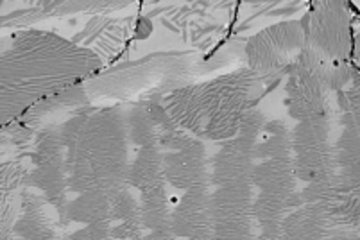All genres
201.
Talk
Phase-field/CALPHAD methods for multi-phase and multi-component microstructures. The 4th International Symposium on Phase Field Modelling in Materials Science (PF 19), Bochum, Germany (2019)
202.
Talk
From Atomistic Understanding to Engineering Design of Advanced Medium and High Manganese Steels. 4th International Conference on medium and high Manganese steels, Aachen, Germany (2019)
203.
Talk
Obtaining constitutive parameters for a physics-based crystal plasticity model from macro-scale behavior. International Conference on Plasticity, Damage, and Fracture , Panama City, Panama (2019)
204.
Talk
DAMASK - Düsseldorf Advanced Material Simulation Kit. Seminar of the Department of Mechanical Engineering and Applied Mechanics, University of Pennsylvania, Philadelphia, PA, USA (2018)
205.
Talk
DAMASK - Düsseldorf Advanced Material Simulation Kit. Seminar of the Department of Mechanical Engineering, Villanova University, Villanova, PA, USA (2018)
206.
Talk
Multi-physics simulation of advanced high strength steels. Thermec 2018, Paris, France (2018)
207.
Talk
DAMASK - The Düsseldorf Advanced Material Simulation Kit for Modeling Multi-Physics Crystal Plasticity, Thermal, and Damage Phenomena. WCCM 2018, 13th World Congress in Computational Mechanics, New York, USA (2018)
208.
Talk
Multi-scale modelling of sheet metal forming by coupling FEM with a CP-Spectral solver using the DAMASK modelling package. 10th European Solid Mechanics Conference (ESMC2018), Bologna, Italy (2018)
209.
Talk
Scalable Quantifying of Evolving Descriptive Spatial Statistics in Full-Field Crystal Plasticity and Atom Probe Tomography. Institut für Metallkunde und Metallphysik, RWTH Aachen University, Aachen, Germany (2018)
210.
Talk
DAMASK: the Düsseldorf Advanced MAterial Simulation Kit for studying multi-physics crystal plasticity phenomena. 10 Years ICAMS - International Symposium, Bochum, Germany (2018)
211.
Talk
DAMASK – From Crystal Plasticity to Multi-Physics. Seminar of the Centre des Matériaux, Paris, France (2018)
212.
Talk
Coupled experimental-computational analysis of plasticity and fracture in aluminum at the grain scale. ECCM-ECFD 2018, Glasgow, UK (2018)
213.
Talk
An improved unified internal state variable model exploiting first principle calculations for flow stress modeling of aluminium alloys. International Conference on Aluminum Alloys (ICAA), Montreal, Canada (2018)
214.
Talk
DAMASK – From Crystal Plasticity to Multi-Physics. Seminar Materials Science and Engineering University of California, Los Angeles, CA, USA (2018)
215.
Talk
Coupled Experimental-Numerical Analysis of Strain Partitioning in Metallic Microstructures: The Importance of a 3D Neighborhood. Schöntal Symposium on 'Dislocation based Plasticity, Schöntal, Germany (2018)
216.
Talk
Including Damage Modelling into Crystal Plasticity Simulations using the Düsseldorf Advanced Material Simulation Kit DAMASK. Symposium Nano and Micro Scale Damage in Metals, Utrecht, The Netherlands (2018)
217.
Talk
Numerical and Experimental Analysis of Strain Localization in Martensite. International Conference on Plasticity, Damage, and Fracture, San Juan, Puerto Rico, USA (2018)
218.
Talk
Simulation Study on Plasticity and Fracture in Aluminium Based on Real Microstructures. TMS 2018 Annual Meeting & Exhibition, Phoenix, AZ, USA (2018)
219.
Talk
Simulation Study on Plasticity and Fracture in Aluminium Based on Real Microstructures. International Conference on Plasticity, Damage, and Fracture, San Juan, Puerto Rico, USA (2018)
220.
Talk
Integrated experimental and simulation analysis of stress and strain partitioning in dual phase steel. Nanomechanical Testing in Materials Research and Development VI, Dubrovnik, Croatia (2017)











